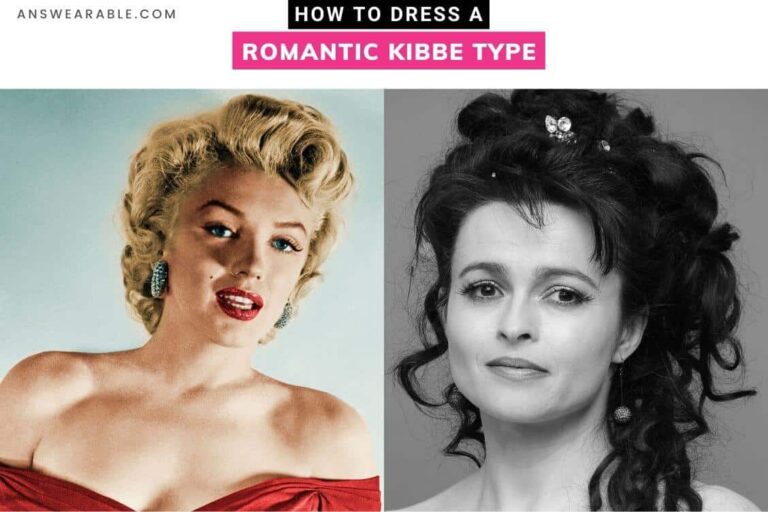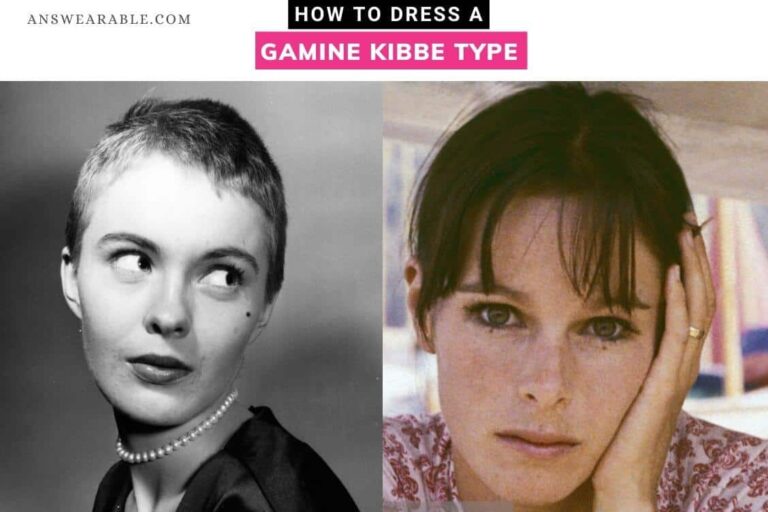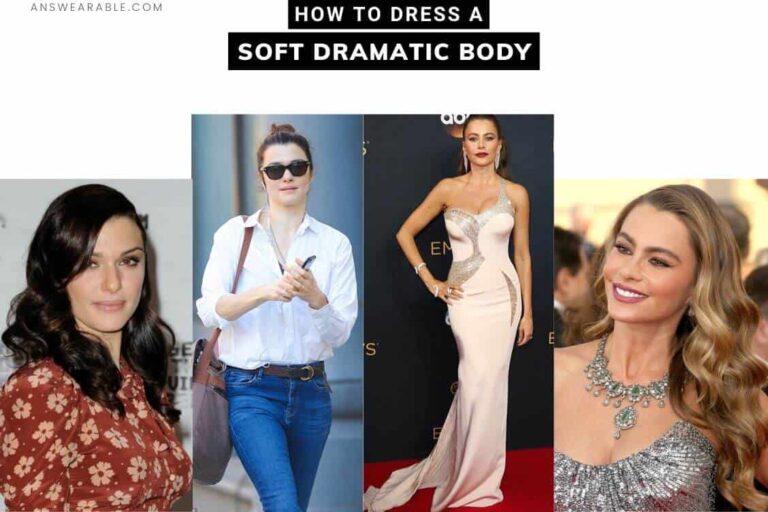As an affiliate, Answearable earns from qualifying purchases at NO cost to you. Learn More.
This article will show you a Classic shopping guide — from casual to formal outfits, accessories, makeup, and coloring and prints
Not sure how a pure Classic looks like? This article will show you with pictures and examples. It will also show you the styling principles.
The following were taken from the book Metamorphosis by David Kibbe, the image professional who created the Kibbe system.
Pure Classic Shopping Guide
1. Dresses
Pure Classics’ dresses should always be elegant, with smooth shapes, softly tailored styling, and slim widths. Waist emphasis should be understated (narrow, elegant belts or ties). Shirtwaists, tailored wraps, soft sheaths, smooth knits, and belted coatdresses are all good.
Avoid:
- sharply tailored styles
- oversized and wide styles
- flouncy styles with ornate detail
2. Separates
As a Pure Classic, use separates carefully and sparingly. An obvious use of separates is counterproductive to your elegance. Make sure colors, textures, and prints blend together to maintain your smooth visual lines.
3. Jackets and blazers
Pure Classics jackets and blazers should always be narrow and tailored with a smooth outline. Standard length is best (just below break of hip). Lightweight unconstructed jackets are fine when they are kept sleek and narrow.
Blazers, cardigan-style, elongated Chanel (not cropped) are all good choices. Slightly longer jackets are possible when the corresponding skirt is also elongated to match.
Avoid:
- boxy jackets
- cropped jackets
- oversized jackets
- overly angular jackets
- flouncy jackets (peplums and nipped-waist styles)
4. Skirts
Pure Classics’ skirts should be kept smooth and simple. Clean lines. Soft and straight or slightly flared. Minimal detail. Moderate length to match jacket length (standard straight: one inch below knee; slightly flared: mid-calf; paired with a long jacket). Softly pleated skirts.
Avoid:
- long, pencil-slim styles
- full, flouncy styles
- overdetailed touches (pockets, gathers, trim)
5. Pants
Clean, tailored styles with a minimum of detail. Plain front or trouserpleated. Slim, narrow shapes.
Avoid:
- extreme man-tailored pants (deep pleats, cuffs, etc.)
- oversized, unconstructed, or baggy shapes
- draped, clingy, tapered shapes
6. Tops and blouses
Smooth tailored styles (elegant silks and soft cottons).
Avoid:
- flouncy or frilly styles
- unconstructed styles
7. Sweaters
Smooth knits. Moderate weight. Ribbed or softly textured.
Avoid:
- clingy knits
- oversized and baggy sweaters
- nubby or roughly textured knits
8. Evening wear
Symmetrical shapes with clean and elegant detail. Smooth fabric. Beaded fabric. Understated trim. The following designs are great choices:
- jacketed gowns
- tailored dinner suits
- smooth chiffon gowns
- simple little cocktail dresses
- beaded jackets and bodices
9. Shoes
Slender pumps. Sling backs. Tapered toes. Narrow heels. Elegant leather. Softly tailored flats
Avoid:
- ornamentation
- overly tailored styles
- chunky or heavy styles
- overly delicate and strappy styles
10. Bags
Crisply tailored. Moderate size. Supple leather. Clutch. Envelope. Tailored briefcase (slim and elegant).
Avoid:
- wide, clunky briefcases
- overly delicate or ornate bags
- oversized, unconstructed bags
11. Belts
Keep elegant, slim, and narrow with small, smooth buckles.
Avoid:
- overly wide, angular belts
- overly ornate belts
12. Hats
Tailored, symmetrical shapes. Small and crisp with even brims.
Avoid: oversized, ornate, or sharply angular hats
13. Hosiery
Blend with hemline and shoe for one long line. Blend with shoe (one or two shades lighter than hemline) for a “light leg” look. Keep sheer or lightly textured.
Avoid:
- opaque stockings
- contrasting the stocking with the hemline and the shoe (too choppy for you)
14. Jewelry
Keep your jewelry elegant, smooth, and symmetrical. Small, slightly geometric shapes are good, as are smoothly curved swirls. Be careful not to overdo! Go “elegant” instead of extreme.
Avoid:
- extremely ornate or intricate pieces
- extremely severe, angular pieces
- chunky and heavy pieces
- funky costume jewelry
- overly dangly styles
- a “no jewelry” look
15. Hair
A Pure Classic’s hair should always be smooth, sleek, and well-groomed. Blunt-edged cuts work best to achieve the even control necessary to complete your look. If your hair is extremely curly, you will need some layering with the curl so it falls in controlled waves. Moderate length is best.
Avoid:
- wild hair
- trendy hair
- severe cuts
- stiff, teased hair
- overly layered cuts
- ornate or lavish hair
- cropped, boyish cuts
16. Haircolor
As a Pure Classic, you should strive for a natural and rich haircolor. Be very subtle in color changes so the effect is realistic. Use lowlights and soft sprays of color instead of highlights and dramatic streaking.
Avoid overly theatrical haircolors (blue-black, platinum, fiery red), unless that’s your original color .
17. Makeup
A Pure Classic’s makeup should be moderate and well-blended with an emphasis on soft colors and neutrals. A matte finish is best. Eyes should be slightly smoky, with just a hint of color. Lips and cheeks will match the eyes in intensity.
Avoid:
- a “no makeup” look
- severe or sharp angles
- overly colorful makeup
- high-contrast makeup (pale skin, vivid colors)
- glitzy products (even for evening — just a touch of sparkle is all you need)
Soft Classic Shopping Guide & Styling Techniques
Shape
Symmetry is the key to all your shapes. Whether slightly geometric or slightly curved, always blend the same shapes together in your look.
Avoid:
- extreme geometrics
- extreme round shapes
- extreme ornate shapes
- extreme, unconstructed shapes
Line and silhouette
Your use of line goes hand-in-hand with your use of shape. Keep your outline smooth and symmetrical with the emphasis on controlled and even edges, soft, straight lines or smoothly curved-lines — softly tailored or slightly flowing.
A clean, unbroken silhouette is your most elegant statement. Think “head-to-toe,” and blend everything accordingly.
Avoid:
- overly sharp silhouettes
- overly flouncy silhouettes
- overly constructed silhouettes (wide)
Fabric
Beautiful, luscious fabrics are an important element in your understated look, which stress your love of quality. Don’t hesitate to spend your money on high quality fabrics — here’s where it will show on you!
Moderate weights. Lightweights in very constructed and tailored garments. Matte finish or slight sheen. Very slight draping in constructed garments.
Luxurious to touch (French silks, Italian gabardines, etc.). Lightweight textures (raw silk, shantung, linen). Smooth knits (cashmere, softly ribbed, heavy jersey. Smooth chiffon and elegantly beaded fabrics for evening.
Avoid:
- heavy fabrics
- rough textures
- sheer or clingy fabrics
- stiff metallics and extremely shiny fabrics (unless lightweight)
Detail
A Pure Classic use of detail should be clean, simple, and minimal — just enough to add an elegantly understated touch. It should never call attention to itself; it should only add to the smooth visual line of your garments.
Include: slight, crisp shoulder padding. Clean, tailored necklines (man-tailored, notched, jewel, slashed, small V’s, turtlenecks, and narrow cowls). Crisp and finished cuffs. Elegant scarves in symmetrical ties (jabots, ascots, self-ties). Symmetrical lapels (notched, smooth shawls, or clean, piped styles). Tailored pleats. Crisp gathers.
Avoid:
- unconstructed detail
- overly animated or “cutesy” detail
- overly ornate detail and fussy trim
- overly sharp, geometric, or angular detail
Accessories
A Classic’s accessory should be simple, clean, and elegant. Here is another place to invest substantially. The quality will definitely show!
Color
Your use of color should accentuate your smoothly blended visual outline. This means that a mixture of colors in an outfit should blend together in intensity so as not to disrupt your clean and smooth silhouette.
Monochromatic schemes are excellent, although you don’t need to be limited to just one or two colors. They key is to make sure the tones (intensities) blend, instead of contrasting. Neutrals in exquisite fabrics are also quite rich-looking on you.
Avoid:
- multicolor splashes
- sharp color contrast
- mix ‘n match color combos
Prints
Pure Classics’ prints should be symmetrical, evenly spaced, and regular or realistic patterns. Understated prints (pin dots, pinstripes, checks, blended plaids, herringbones, symmetrical paisleys, etc.).
Avoid:
- sharp and angular geometrics
- contemporary, avant-garde prints
- splashy watercolors or abstract florals
- ornate prints
- oversized prints
- animated prints
One Comment
Comments are closed.



















In pure dramatic there are pics of examplesbut there aren’t any here i’m a visual learner so pics would help.